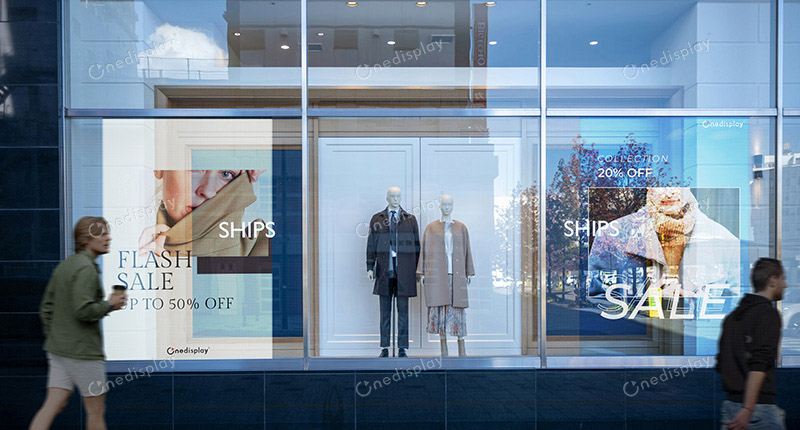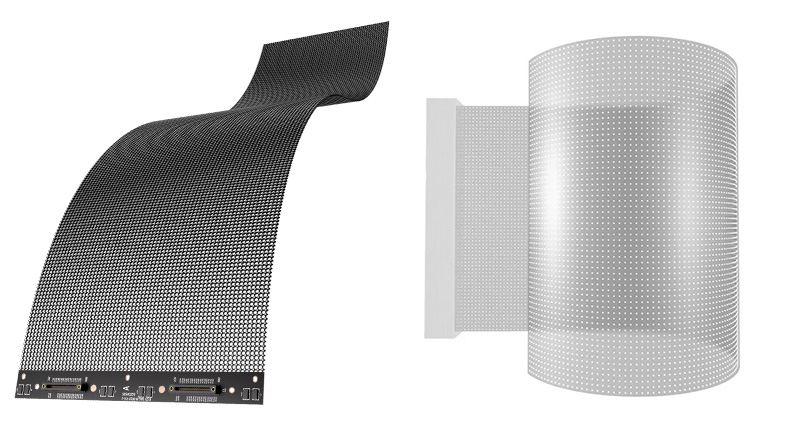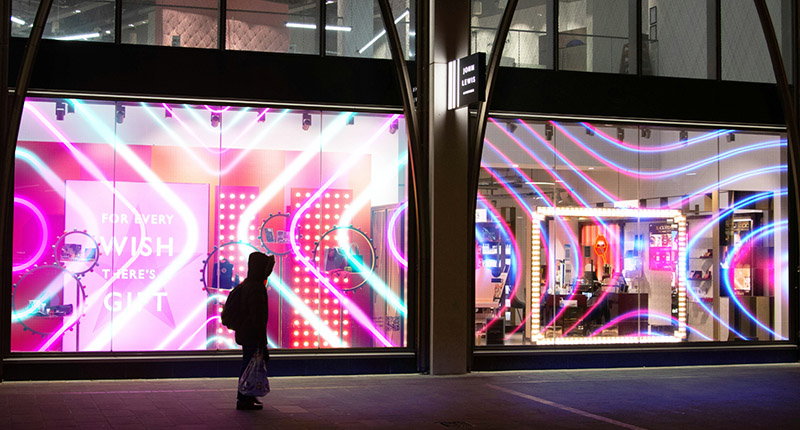If you work in retail, exhibitions, hospitality, or corporate spaces, you’ve probably seen two buzzworthy display options popping up everywhere: Film LED screens and Holographic (a.k.a. Transparent) LED screens. They both promise “see-through visuals,” futuristic vibes, and minimal intrusion into your space. But under the hood, they’re built differently—and those differences matter for image quality, installation, maintenance, and cost of ownership.
In this guide, we’ll break down the core differences between Film LED Screen and Holographic LED Screen in plain word, so you can choose the right tech for your space and goals.

The Big Picture: What Are They?
- Film LED Screen (LED Film) What it is: An ultra-thin, flexible, transparent LED film that sticks directly onto glass (windows, storefronts, glass partitions). Think of it as a “display sticker” that turns your glass into a screen. How it looks: When off, the glass remains largely see-through. When on, content appears as bright pixels “floating” on the glass.
- Holographic LED Screen (Transparent/Holographic LED) What it is: A modular, transparent LED panel system made of narrow LED strips or mesh. It’s rigid or semi-rigid, installed in front of glass facades, on truss frames, or suspended structures. How it looks: Content appears “floating” in space with a strong sense of depth. From a distance, it can feel hologram-like, especially with dark backgrounds and controlled lighting.
Transparency vs. Visual Punch
- Transparency (how much you can see through it) Film LED : Very high transparency, often 85%+. Great for maintaining storefront visibility and daylight intake. Holographic LED : Also high, typically 60–90% depending on pixel pitch and strip design. Transparency can drop as you choose higher resolution.
- Perceived Image Quality Film LED: Looks clean and integrated on glass. Best for short to mid-range viewing (1–8 meters). Great for retail windows, museums, office lobbies. Holographic LED: Stronger “wow factor” at medium to long viewing distances (5–30+ meters). The depth and brightness can read as more “3D” in larger venues.
Brightness and Daylight Performance
- Film LED Brightness: Moderate to high, but typically below the maximum of structural transparent LED panels. Use case: Excellent for indoor-facing windows and shaded storefronts. In direct sunlight, you’ll need high-brightness models and good content design (high contrast, bold colors).
- Holographic LED Brightness: Generally higher compared to LED film due to larger LED packages and open-frame structures. Use case: Performs better in bright atriums, glass facades, and semi-outdoor scenarios. More resilient against strong ambient light.
Pixel Pitch and Viewing Distance
- Film LED Pixel pitch: Usually finer in close-range applications (depends on model). Ideal for viewers standing a few meters away. Takeaway: If your audience is close—like shoppers on the sidewalk or visitors in a lobby—film LED can look sharper at short distances.
- Holographic LED Pixel pitch: Often wider than film LEDs, optimized for bigger displays and farther viewing distances. Takeaway: If your audience is across a plaza, in a mall atrium, or at an event stage, the holographic screen will pop from afar.
Installation: Stick vs. Build
- Film LED Form factor: Thin, light, flexible film with embedded LEDs and conductive traces. Install: Applied directly onto existing glass; wiring routed at the edges to a controller and power supply. Impact: Minimal structural changes, fast rollout, low profile. Ideal for rentals where building changes aren’t allowed.
- Holographic LED Form factor: Modular frames or mesh with integrated LED strips. Install: Mounted on frames, beams, or suspended systems; may require structural assessment and rigging. Impact: More involved installation, but scalable to very large sizes and irregular shapes.
Weight, Thickness, and Aesthetics When Off
- Film LED Screen Weight: Extremely light. Thickness: Ultra-thin; essentially becomes part of the glass. Aesthetics (off): The glass remains clean and open; minimal visual clutter.
- Holographic LED Screen Weight: Light compared to traditional LED cabinets, but heavier than film. Thickness: Slim frames, but still visible structure. Aesthetics (off): You’ ll notice the strip grid up close, though it disappears at a distance.
Maintenance and Durability
- Film LED Maintenance: Harder to service pixel-by-pixel because it’s adhered to the glass. Best to choose reliable film and proper power management. Durability: Suitable for indoor or protected environments. Avoid harsh cleaning agents or physical abrasion.
- Holographic LED Maintenance: Modular—faulty strips or modules can be swapped. Better for long-term, heavy-duty use. Durability: Robust for events, large venues, and high-traffic installs.
Content Strategy: What Works Best?
- Film LED Best content: High-contrast, bold graphics, generous negative space. Text should be thicker; subtle gradients can get lost on bright days. Storytelling style: Elegant overlays on real-world views—think floating promotions, animated patterns, ambient art.
- Holographic LED Best content: Large-format motion, strong contrast, 3D illusions, and brand moments that benefit from depth. Storytelling style: Spectacle and scale—product reveals, live shows, atrium-scale ads, immersive stage design.
Power Consumption and Heat
- Film LED Power: Low to moderate; efficient for continuous, all-day retail use. Heat: Minimal; does not add bulk to HVAC considerations in most indoor settings.
- Holographic LED Power: Higher at equivalent brightness due to larger LED packages and structural design—but still efficient compared to traditional LED walls. Heat: Manageable, but consider ventilation and access for larger arrays.
Budget and Total Cost of Ownership
- Film LED Upfront cost: Competitive for small to medium glass areas. Hidden costs: Less labor, minimal structure, fast deployment. Potential replacement cost if damaged film needs reapplication.
- Holographic LED Upfront cost: Scales with size and pixel pitch; structure and rigging add to the budget. Hidden costs: Serviceability is better; long-term maintenance can be more predictable for large-scale installs.
When to Choose Which?
Pick Film LED Screen if:
- You need minimal intrusion and maximum transparency on existing glass.
- Your audience stands close (storefronts, showrooms, museums, office lobbies).
- You prioritize clean aesthetics when the screen is off.
- You want quick, lightweight installation with limited structural work.
Pick Holographic LED Screen if:
- You need big visual impact at a distance (atriums, stages, event halls).
- Your environment is bright or semi-outdoor and demands higher brightness.
- You want modularity for maintenance and large-format scalability.
- You’re designing immersive, “floating” visuals with dramatic depth.
Summary
Both display types are “see-through,” but they serve different missions.
- Film LED is like turning your window into a gentle, elegant display—perfect for close-up engagement and subtle branding without blocking the view.
- Holographic LED is like hanging a transparent stage in the air—built for scale, brightness, and spectacle that grabs attention from across the room.
Tips: Match the tech to your viewing distance, ambient light, content style, and installation constraints. If you can, seeing both in your actual environment is the fastest way to make a confident choice.
Si deseas saber más información y precios ¡contáctanos!



